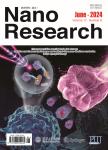Self-formation of hexagonal nanotemplates for growth of pyramidal quantum dots by metalorganic vapor phase epitaxy on patterned substrates
Self-formation of hexagonal nanotemplates for growth of pyramidal quantum dots by metalorganic vapor phase epitaxy on patterned substrates作者机构:Laboratory of Physics of Nanostructures Ecole Polytechnique Federale de Lausanne CH- 1015 Lausanne Switzerland
出 版 物:《Nano Research》 (纳米研究(英文版))
年 卷 期:2016年第9卷第11期
页 面:3279-3290页
核心收录:
学科分类:080903[工学-微电子学与固体电子学] 0809[工学-电子科学与技术(可授工学、理学学位)] 08[工学] 080501[工学-材料物理与化学] 0805[工学-材料科学与工程(可授工学、理学学位)] 080502[工学-材料学]
基 金:The authors gratefully acknowledge funding from the Swiss National Science Foundation
主 题:metalorganic vapor phaseepitax kinetic Monte Carlosimulations epitaxial growth onpatterned substrates symmetry elevation adatom diffusion
摘 要:We demonstrate the self-formation of hexagonal nanotemplates on GaAs (111)B substrates patterned with arrays of inverted tetrahedral pyramids during metal-organic vapor phase epitaxy and its role in producing high-symmetry, site-controlled quantum dots (QDs). By combining atomic force microscopy measurements on progressively thicker GaAs epitaxial layers with kinetic Monte Carlo growth simulations, we demonstrate self-maintained symmetry elevation of the QD formation sites from three-fold to six-fold symmetry. This symmetry elevation stems from adatom fluxes directed towards the high-curvature sites of the template, resulting in the formation of a fully three-dimensional hexagonal template after the deposition of relatively thin GaAs layers. We identified the growth conditions for consistently achieving a hexagonal pyramid bottom, which are useful for producing high-symmetry QDs for efficient generation of entangled photons.



